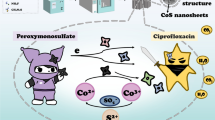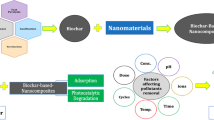Abstract
Due to public concern about tetracycline (TC), it is imperative to eliminate this compound from the environment. This article describes the preparation of an efficient and low-cost porous copper alginate/graphene oxide (CA/GO) composite material by freeze-drying. The application of tetracycline removal in the presence of persulfate (PS) was studied. The effects of pH, PS, catalyst dosage and tetracycline concentration on adsorption and degradation were investigated. The synthesized composites were characterized by Scanning electron microscope (SEM), Fourier Transform infrared spectroscopy (FTIR) and Thermogravimetric analysis (TGA). The degradation rate of tetracycline increases with the increase of the compound dose, and decreases with the increase of the initial pH. The adsorption of tetracycline by this catalyst is suitable for Langmuir model. Under the optimum conditions, the removal efficiency of tetracycline was up to 98%. The high reactivity of the composite material is closely related to its redox ability. At the same time, the reusability of the material was studied. After being recycled four times under the same conditions, the removal rate of tetracycline reached about 85%.










Similar content being viewed by others
References
Xiong W, Zeng Z, Zeng G, Yang Z, Xiao R, Li X, Cao J, Zhou C, Chen H, Jia M, Yang Y, Wang W, Tang X (2019) Metal-organic frameworks derived magnetic carbon-αFe/Fe3C composites as a highly effective adsorbent for tetracycline removal from aqueous solution. Chem Eng J 374:91–99. https://doi.org/10.1016/j.cej.2019.05.164
Yuan X, Shen D, Zhang Q, Zou H, Liu Z, Peng F (2019) Z-scheme Bi2WO6/CuBi2O4 heterojunction mediated by interfacial electric field for efficient visible-light photocatalytic degradation of tetracycline. Chem Eng J 369:292–301. https://doi.org/10.1016/j.cej.2019.03.082
Zhou C, Huang D, Xu P, Zeng G, Huang J, Shi T, Lai C, Zhang C, Cheng M, Lu Y, Duan A, Xiong W, Zhou M (2019) Efficient visible light driven degradation of sulfamethazine and tetracycline by salicylic acid modified polymeric carbon nitride via charge transfer. Chem Eng J 370:1077–1086. https://doi.org/10.1016/j.cej.2019.03.279
Lin Z, Li M, Gehring R, Riviere JE (2015) Development and application of a multiroute physiologically based pharmacokinetic model for oxytetracycline in dogs and humans. J Pharm Sci 104(1):233–243. https://doi.org/10.1002/jps.24244
He D, Sun Y, Xin L, Feng J (2015) Corrigendum to “aqueous tetracycline degradation by non-thermal plasma combined with nano-TiO2” [Chem. Eng. J. (2014) 18–25]. Chem Eng J 262:1311. https://doi.org/https://doi.org/10.1016/j.cej.2014.10.084
Peiris C, Gunatilake SR, Mlsna TE, Mohan D, Vithanage M (2017) Biochar based removal of antibiotic sulfonamides and tetracyclines in aquatic environments: a critical review. Bioresour Technol 246:150–159. https://doi.org/10.1016/j.biortech.2017.07.150
Calisto V, Ferreira CIA, Oliveira JABP, Otero M, Esteves VI (2015) Adsorptive removal of pharmaceuticals from water by commercial and waste-based carbons. J Environ Manage 152:83–90. https://doi.org/10.1016/j.jenvman.2015.01.019
Luo Y, Xu L, Rysz M, Wang Y, Zhang H, Alvarez PJ (2011) Occurrence and transport of tetracycline, sulfonamide, quinolone, and macrolide antibiotics in the Haihe River Basin. China Environ Sci Technol 45(5):1827–1833. https://doi.org/10.1021/es104009s
Pham TTH, Rossi P, Dinh HDK, Pham NTA, Tran PA, Ho T, Dinh QT, De Alencastro LF (2018) Analysis of antibiotic multi-resistant bacteria and resistance genes in the effluent of an intensive shrimp farm (Long An, Vietnam). J Environ Manage 214:149–156. https://doi.org/10.1016/j.jenvman.2018.02.089
Xu J, Zhang Y, Zhou C, Guo C, Wang D, Du P, Luo Y, Wan J, Meng W (2014) Distribution, sources and composition of antibiotics in sediment, overlying water and pore water from Taihu Lake, China. Sci Total Environ 497–498:267–273. https://doi.org/10.1016/j.scitotenv.2014.07.114
Daghrir R, Drogui P (2013) Tetracycline antibiotics in the environment: a review. Environ Chem Lett 11(3):209–227. https://doi.org/10.1007/s10311-013-0404-8
Zhuang Y, Liu QZ, Kong Y, Shen CC, Hao HT, Dionysiou DD, Shi BY (2019) Enhanced antibiotic removal through a dual-reaction-center fenton-like process in 3D graphene based hydrogels. Environ-Sci Nano 6(2):388–398. https://doi.org/10.1039/c8en01339j
Zhuang Y, Yu F, Chen H, Zheng J, Ma J, Chen JH (2016) Alginate/graphene double-network nanocomposite hydrogel beads with low-swelling, enhanced mechanical properties, and enhanced adsorption capacity. J Mater Chem A 4(28):10885–10892. https://doi.org/10.1039/c6ta02738e
Yu W, Wen Q, Yang J, Xiao K, Zhu Y, Tao S, Lv Y, Liang S, Fan W, Zhu S, Liu B, Hou H, Hu J (2019) Unraveling oxidation behaviors for intracellular and extracellular from different oxidants (HOCl vs. H2O2) catalyzed by ferrous iron in waste activated sludge dewatering. Water Res 148:60–69. https://doi.org/10.1016/j.watres.2018.10.033
Zhang Y, Zhou J, Chen X, Wang L, Cai W (2019) Coupling of heterogeneous advanced oxidation processes and photocatalysis in efficient degradation of tetracycline hydrochloride by Fe-based MOFs: synergistic effect and degradation pathway. Chem Eng J 369:745–757. https://doi.org/10.1016/j.cej.2019.03.108
Dong X, Ren B, Sun Z, Li C, Zhang X, Kong M, Zheng S, Dionysiou DD (2019) Monodispersed CuFe2O4 nanoparticles anchored on natural kaolinite as highly efficient peroxymonosulfate catalyst for bisphenol A degradation. Appl Catal B 253:206–217. https://doi.org/10.1016/j.apcatb.2019.04.052
Liu X, Huang F, Yu Y, Zhao P, Zhou Y, He Y, Xu Y, Zhang Y (2019) Ofloxacin degradation over Cu–Ce tyre carbon catalysts by the microwave assisted persulfate process. Appl Catal B 253:149–159. https://doi.org/10.1016/j.apcatb.2019.04.047
Yu J, Tang L, Pang Y, Zeng G, Wang J, Deng Y, Liu Y, Feng H, Chen S, Ren X (2019) Magnetic nitrogen-doped sludge-derived biochar catalysts for persulfate activation: internal electron transfer mechanism. Chem Eng J 364:146–159. https://doi.org/10.1016/j.cej.2019.01.163
Zhang D, Wu L, Yao J, Herrmann H, Richnow H-H (2018) Carbon and hydrogen isotope fractionation of phthalate esters during degradation by sulfate and hydroxyl radicals. Chem Eng J 347:111–118. https://doi.org/10.1016/j.cej.2018.04.047
Dong CD, Chen CW, Tsai ML, Hung CM (2019) The efficacy and cytotoxicity of iron oxide-carbon black composites for liquid-phase toluene oxidation by persulfate. Environ Sci Pollut Res Int 26(15):14786–14796. https://doi.org/10.1007/s11356-018-3593-7
Du J, Bao J, Liu Y, Ling H, Zheng H, Kim SH, Dionysiou DD (2016) Efficient activation of peroxymonosulfate by magnetic Mn-MGO for degradation of bisphenol A. J Hazard Mater 320:150–159. https://doi.org/10.1016/j.jhazmat.2016.08.021
Facchi DP, Cazetta AL, Canesin EA, Almeida VC, Bonafé EG, Kipper MJ, Martins AF (2018) New magnetic chitosan/alginate/Fe3O4@SiO2 hydrogel composites applied for removal of Pb(II) ions from aqueous systems. Chem Eng J 337:595–608. https://doi.org/10.1016/j.cej.2017.12.142
Xiong W, Ren C, Tian M, Yang X, Li J, Li B (2018) Emulsion stability and dilatational viscoelasticity of ovalbumin/chitosan complexes at the oil-in-water interface. Food Chem 252:181–188. https://doi.org/10.1016/j.foodchem.2018.01.067
Su C, Acik M, Takai K, Lu J, Hao SJ, Zheng Y, Wu P, Bao Q, Enoki T, Chabal YJ, Loh KP (2012) Probing the catalytic activity of porous graphene oxide and the origin of this behaviour. Nat Commun 3:1298. https://doi.org/10.1038/ncomms2315
Zhang XP, Li YH, Li MX, Zheng H, Du QJ, Li H, Wang YQ, Wang DC, Wang CP, Sui KY, Li HL, Xia YZ (2019) Preparation of improved gluten material and its adsorption behavior for congo red from aqueous solution. J Colloid Interface Sci 556:249–257. https://doi.org/10.1016/j.jcis.2019.08.037
Zhang XP, Li YH, Li MX, Zheng H, Du QJ, Li H, Wang YQ, Wang DC, Wang CP, Sui KY, Li HL, Xia YZ (2020) Removal of methylene blue from aqueous solution using high performance calcium alginate/activated carbon membrane. Int J Cloth Sci Technol 32(3):307–321. https://doi.org/10.1108/ijcst-03-2019-0044
Kang J, Liu H, Zheng Y-M, Qu J, Chen JP (2010) Systematic study of synergistic and antagonistic effects on adsorption of tetracycline and copper onto a chitosan. J Colloid Interface Sci 344(1):117–125. https://doi.org/10.1016/j.jcis.2009.11.049
Lu X, Gao Y, Luo J, Yan S, Rengel Z, Zhang Z (2014) Interaction of veterinary antibiotic tetracyclines and copper on their fates in water and water hyacinth (Eichhornia crassipes). J Hazard Mater 280:389–398. https://doi.org/10.1016/j.jhazmat.2014.08.022
Lau YY, Wong YS, Ang TZ, Ong SA, Lutpi NA, Ho LN (2018) Degradation reaction of Diazo reactive black 5 dye with copper (II) sulfate catalyst in thermolysis treatment. Environ Sci Pollut Res Int 25(7):7067–7075. https://doi.org/10.1007/s11356-017-1069-9
Nguyen V-T, Hung C-M, Nguyen T-B, Chang J-H, Wang T-H, Wu C-H, Lin Y-L, Chen C-W, Dong C-D (2019) Efficient heterogeneous activation of persulfate by iron-modified biochar for removal of antibiotic from aqueous solution: a case study of tetracycline removal. Catalysts. https://doi.org/10.3390/catal9010049
Nguyen V-T, Nguyen T-B, Chen C-W, Hung C-M, Huang CP, Dong C-D (2019) Cobalt-impregnated biochar (Co-SCG) for heterogeneous activation of peroxymonosulfate for removal of tetracycline in water. Biores Technol 292:121954. https://doi.org/10.1016/j.biortech.2019.121954
Nguyen V-T, Nguyen T-B, Chen C-W, Hung C-M, Vo T-D-H, Chang J-H, Dong C-D (2019) Influence of pyrolysis temperature on polycyclic aromatic hydrocarbons production and tetracycline adsorption behavior of biochar derived from spent coffee ground. Bioresour Technol 284:197–203. https://doi.org/10.1016/j.biortech.2019.03.096
George G, Saravanakumar MP (2018) Facile synthesis of carbon-coated layered double hydroxide and its comparative characterisation with Zn–Al LDH: application on crystal violet and malachite green dye adsorption—isotherm, kinetics and Box-Behnken design. Environ Sci Pollut Res 25(30):30236–30254. https://doi.org/10.1007/s11356-018-3001-3
Safari GH, Nasseri S, Mahvi AH, Yaghmaeian K, Nabizadeh R, Alimohammadi M (2015) Optimization of sonochemical degradation of tetracycline in aqueous solution using sono-activated persulfate process. J Environ Health Sci Eng 13:76. https://doi.org/10.1186/s40201-015-0234-7
Matzek LW, Carter KE (2016) Activated persulfate for organic chemical degradation: a review. Chemosphere 151:178–188. https://doi.org/10.1016/j.chemosphere.2016.02.055
Cheng Y, Song W, Liu J, Zheng H, Zhao Z, Xu C, Wei Y, Hensen EJM (2017) Simultaneous NOx and particulate matter removal from diesel exhaust by hierarchical Fe-doped Ce-Zr oxide. ACS Catal 7(6):3883–3892. https://doi.org/10.1021/acscatal.6b03387
Marzbali MH, Esmaieli M, Abolghasemi H, Marzbali MH (2016) Tetracycline adsorption by H3PO4-activated carbon produced from apricot nut shells: a batch study. Process Saf Environ Prot 102:700–709. https://doi.org/10.1016/j.psep.2016.05.025
Palominos RA, Mondaca MA, Giraldo A, Peñuela G, Pérez-Moya M, Mansilla HD (2009) Photocatalytic oxidation of the antibiotic tetracycline on TiO2 and ZnO suspensions. Catal Today 144(1):100–105. https://doi.org/10.1016/j.cattod.2008.12.031
Fujioka N, Suzuki M, Kurosu S, Kawase Y (2016) Linkage of iron elution and dissolved oxygen consumption with removal of organic pollutants by nanoscale zero-valent iron: effects of pH on iron dissolution and formation of iron oxide/hydroxide layer. Chemosphere 144:1738–1746. https://doi.org/10.1016/j.chemosphere.2015.10.064
Fang G, Liu C, Gao J, Dionysiou DD, Zhou D (2015) Manipulation of persistent free radicals in biochar to activate persulfate for contaminant degradation. Environ Sci Technol 49(9):5645–5653. https://doi.org/10.1021/es5061512
Duan X, Su C, Zhou L, Sun H, Suvorova A, Odedairo T, Zhu Z, Shao Z, Wang S (2016) Surface controlled generation of reactive radicals from persulfate by carbocatalysis on nanodiamonds. Appl Catal B 194:7–15. https://doi.org/10.1016/j.apcatb.2016.04.043
Furman OS, Teel AL, Watts RJ (2010) Mechanism of base activation of persulfate. Environ Sci Technol 44(16):6423–6428. https://doi.org/10.1021/es1013714
Acknowledgements
This work was supported by the National Natural Science Foundation of China (51672140), Taishan Scholar Project of Shandong Province (201511029).
Author information
Authors and Affiliations
Corresponding author
Additional information
Publisher's Note
Springer Nature remains neutral with regard to jurisdictional claims in published maps and institutional affiliations.
Rights and permissions
About this article
Cite this article
Cui, M., Li, Y., Sun, Y. et al. Degradation of Tetracycline in Polluted Wastewater by Persulfate over Copper Alginate/Graphene Oxide Composites. J Polym Environ 29, 2227–2235 (2021). https://doi.org/10.1007/s10924-020-02038-6
Accepted:
Published:
Issue Date:
DOI: https://doi.org/10.1007/s10924-020-02038-6




